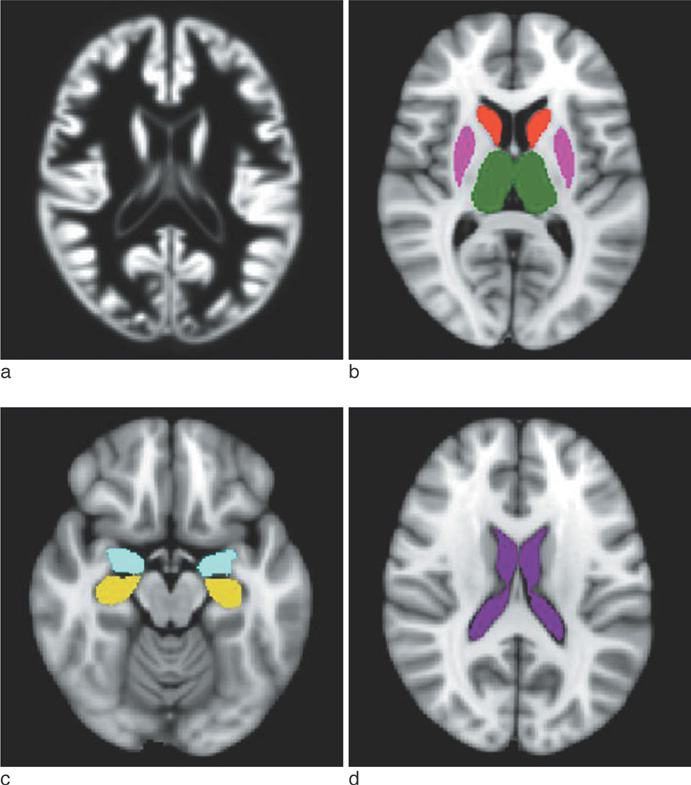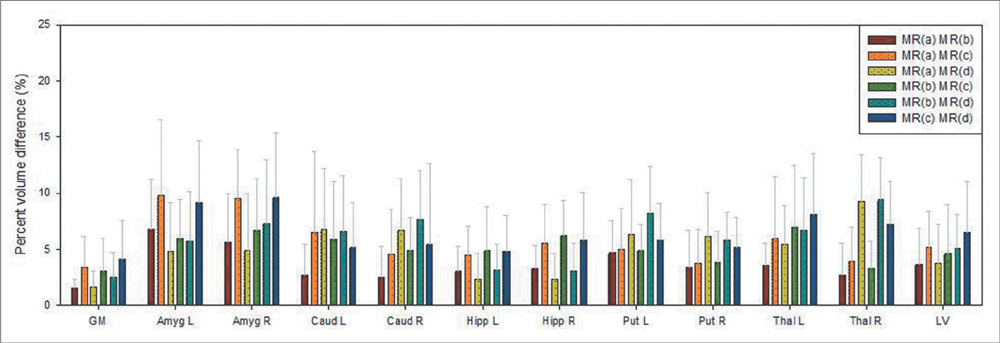J Korean Soc Magn Reson Med.
2012 Dec;16(3):243-252. 10.13104/jksmrm.2012.16.3.243.
Reproducibility Analysis of Brain Volumetry Measured from Inter MR Scanner of Multi-Institute
- Affiliations
-
- 1Department of Biomedical Engineering, and U-Health care Research Center, Inje University, Korea. mcw@inje.ac.kr
- 2Department of Diagnostic Radiology, Haeundae Paik Hospital, Korea.
- 3Department of Psychiatry, Medical School, Pusan National University, Pusan National University Hospital, Korea.
- 4Department of Psychiatry, Medical School, Inje University, Haeundae Paik Hospital, Korea.
- 5Department of Diagnostic Radiology, Medical School, Inje University, Haeundae Paik Hospital, Korea.
- KMID: 2099860
- DOI: http://doi.org/10.13104/jksmrm.2012.16.3.243
Abstract
- PURPOSE
The aim of this study was to evaluate the variations of brain volumetry between the different MR scanners or the different institutes.
MATERIALS AND METHODS
Ten normal subjects were scanned at four different MR scanners, two of them were the same models, to measure inter-MR scanner variations using intraclass correlation coefficient (ICC), coefficient of variation (CV) and percent volume difference (PVD) and to calculate minimal thresholds to detect the significant volumetric changes in gray matter and subcortical regions.
RESULTS
Averaged statistical reliability (ICC = 0.837) and volumetric variation (CV = 4.310%) in all segmented regions were observed on overall MR scanners. Comparing the segmented volumes with PVD between two MR scanners, volumetric differences on same models were the lowest (PVD = 3.611%) and volume thresholds were calculated with 7.168%. PVD results and thresholds values on systemically different MR scanners were evaluated with 5.785% and 11.340% respectively.
CONCLUSION
Authors conclude that the reliability of brain volumetry is not so high. Calibration studies of MRI system and image processing are essential to reduce the volumetric variability. Additionally, frameworks comprised of database and algorithms with high-speed image processing are also required for the efficient image data management.
Keyword
MeSH Terms
Figure
Reference
-
1. Basser PJ, Pierpaoli C. Microstructural and physiological features of tissues elucidated by quantitative-diffusion-tensor MRI. J Magn Reson B. 1996. 111:209–219.2. Voss HU, Schiff ND. MRI of neuronal network structure, function, and plasticity. Prog Brain Res. 2009. 175:483–496.3. Whitwell JL. Voxel-based morphometry: an automated technique for assessing structural changes in the brain. J Neurosci. 2009. 29:9661–9664.4. Um M, Park B, Park HJ. Anatomical Brain Connectivity Map of Korean Children. J Korean Soc Magn Reson Med. 2011. 15:110–122.5. Scahill RI, Frost C, Jenkins R, Whitwell JL, Rossor MN, Fox NC. A longitudinal study of brain volume changes in normal aging using serial registered magnetic resonance imaging. Arch Neurol. 2003. 60:989–994.6. Ge Y, Grossman RI, Babb JS, Rabin ML, Mannon LJ, Kolson DL. Age-related total gray matter and white matter changes in normal adult brain. Part I: volumetric MR imaging analysis. AJNR Am J Neuroradiol. 2002. 23:1327–1333.7. Choi S, Kim WY, Lee KN, et al. The age-related microstructural changes of the cortical gray and white matter ratios on T2-, FLAIR and T1-weighted MR images. J Korean Soc Magn Reson Med. 2011. 15:32–40.8. Guo X, Wang Z, Li K, et al. Voxel-based assessment of gray and white matter volumes in Alzheimer's disease. Neurosci Lett. 2010. 468:146–150.9. Geng D, Li YX, Zee CS. Magnetic resonance imaging-based volumetric analysis of basal ganglia nuclei and substantia nigra in patients with Parkinson's disease. Neurosurgery. 2006. 58:256–262.10. Mascalchi M, Lolli F, Della Nave R, et al. Huntington disease: volumetric, diffusion-weighted, and magnetization transfer MR imaging of brain1. Radiology. 2004. 232:867–873.11. Mathalon DH, Sullivan EV, Lim KO, Pfefferbaum A. Progressive brain volume changes and the clinical course of schizophrenia in men: a longitudinal magnetic resonance imaging study. Arch Gen Psychiatry. 2001. 58:148–157.12. Koolschijn P, Van Haren NEM, Lensvelt-Mulders GJLM, Hulshoff Pol HE, Kahn RS. Brain volume abnormalities in major depressive disorder: a meta-analysis of magnetic resonance imaging studies. Hum Brain Mapp. 2009. 30:3719–3735.13. Blumberg HP, Kaufman J, Martin A, et al. Amygdala and hippocampal volumes in adolescents and adults with bipolar disorder. Arch Gen Psychiatry. 2003. 60:1201–1208.14. Mascalchi M, Lolli F, Della Nave R, et al. Huntington disease: volumetric, diffusion-weighted, and magnetization transfer MR imaging of brain. Radiology. 2004. 232:867.15. Pievani M, De Haan W, Wu T, Seeley WW, Frisoni GB. Functional network disruption in the degenerative dementias. Lancet Neurol. 2011. 10:829–843.16. van de Pol LA, Korf ESC, van der Flier WM, et al. Magnetic resonance imaging predictors of cognition in mild cognitive impairment. Arch Neurol. 2007. 64:1023.17. Fazekas F, Kapeller P, Schmidt R, Offenbacher H, Payer F, Fazekas G. The relation of cerebral magnetic resonance signal hyperintensities to Alzheimer's disease. J Neurol Sci. 1996. 142:121–125.18. Schmidt R, Schmidt H, Kapeller P, et al. The natural course of MRI white matter hyperintensities. J Neurol Sci. 2002. 203:253–257.19. Reiss AL, Eckert MA, Rose FE, et al. An experiment of nature: brain anatomy parallels cognition and behavior in Williams syndrome. J Neurosci. 2004. 24:5009–5015.20. Eckert MA, Tenforde A, Galaburda AM, et al. To modulate or not to modulate: differing results in uniquely shaped Williams syndrome brains. Neuroimage. 2006. 32:1001–1007.21. Zhu T, Hu R, Qiu X, et al. Quantification of accuracy and precision of multi-center DTI measurements: a diffusion phantom and human brain study. Neuroimage. 2011. 56:1398–1411.22. Suckling J, Ohlssen D, Andrew C, et al. Components of variance in a multicentre functional MRI study and implications for calculation of statistical power. Hum Brain Mapp. 2008. 29:1111–1122.23. Suckling J, Barnes A, Job D, et al. Power calculations for multicenter imaging studies controlled by the false discovery rate. Hum Brain Mapp. 2010. 31:1183–1195.24. Jack CR Jr, Bernstein MA, Fox NC, et al. The Alzheimer's disease neuroimaging initiative (ADNI): MRI methods. J Magn Reson Imaging. 2008. 27:685–691.25. Moorhead TW, Gountouna VE, Job D, et al. Prospective multi-centre voxel based morphometry study employing scanner specific segmentations: procedure development using CaliBrain structural MRI data. BMC Med Imaging. 2009. 9:8.26. Balamoody S, Williams T, Waterton J, et al. Comparison of 3T MR scanners in regional cartilage-thickness analysis in osteoarthritis: a cross-sectional multicenter, multivendor study. Arthritis Res Ther. 2010. 12:202.27. Takao H, Hayashi N, Ohtomo K. Effect of scanner in longitudinal studies of brain volume changes. J Magn Reson Imaging. 2011. 34:438–444.28. Friston KJ, Holmes AP, Worsley KJ, Poline JP, Frith CD, Frackowiak RSJ. Statistical parametric maps in functional imaging: a general linear approach. Hum Brain Mapp. 1994. 2:189–210.29. May A, Gaser C. Magnetic resonance-based morphometry: a window into structural plasticity of the brain. Curr Opin Neurol. 2006. 19:407.30. Fischl B, Salat DH, Busa E, et al. Whole brain segmentation: automated labeling of neuroanatomical structures in the human brain. Neuron. 2002. 33:341–355.31. Fischl B, Salat DH, van der Kouwe AJW, et al. Sequence-independent segmentation of magnetic resonance images. NeuroImage. 2004. 23:Suppl 1. S69–S84.32. Cocosco CA, Kollokian V, Pike GB, Evans AC. BrainWeb: online interface to a 3D MRI simulated brain database. Neuroimage. 1997. 5:425.33. Klauschen F, Goldman A, Barra V, Meyer-Lindenberg A, Lundervold A. Evaluation of automated brain MR image segmentation and volumetry methods. Hum Brain Mapp. 2009. 30:1310–1327.34. Morey RA, Petty CM, Xu Y, Pannu Hayes J, Wagner HR II, Lewis DV. A comparison of automated segmentation and manual tracing for quantifying hippocampal and amygdala volumes. Neuroimage. 2009. 45:855–866.35. Pardoe HR, Pell GS, Abbott DF, Jackson GD. Hippocampal volume assessment in temporal lobe epilepsy: how good is automated segmentation? Epilepsia. 2009. 50:2586–2592.36. Scahill RI, Schott JM, Stevens JM, Rossor MN, Fox NC. Mapping the evolution of regional atrophy in Alzheimer's disease: unbiased analysis of fluid-registered serial MRI. Proc Natl Acad Sci U S A. 2002. 99:4703.37. McDonald C, McEvoy L, Gharapetian L, et al. Regional rates of neocortical atrophy from normal aging to early Alzheimer disease. Neurology. 2009. 73(6):457–465.38. De Jong L, Van Der Hiele K, Veer I, et al. Strongly reduced volumes of putamen and thalamus in Alzheimer's disease: an MRI study. Brain. 2008. 131:3277–3285.39. Shear PK, Sullivan EV, Mathalon DH, et al. Longitudinal volumetric computed tomographic analysis of regional brain changes in normal aging and Alzheimer's disease. Arch Neurol. 1995. 52:392.40. Sullivan E, Pfefferbaum A, Adalsteinsson E, Swan G, Carmelli D. Differential rates of regional brain change in callosal and ventricular size: a 4-year longitudinal MRI study of elderly men. Cerebral Cortex. 2002. 12:438–445.41. Lee S, Kim S, Tae W, et al. Regional volume analysis of the Parkinson disease brain in early disease stage: gray matter, white matter, striatum, and thalamus. AJNR Am J Neuroradiol. 2011. 32:682–687.42. Asami T, Bouix S, Whitford TJ, Shenton ME, Salisbury DF, McCarley RW. Longitudinal loss of gray matter volume in patients with first-episode schizophrenia: DARTEL automated analysis and ROI validation. Neuroimage. 2011. 59:986–996.43. Seidman LJ, Faraone SV, Goldstein JM, et al. Thalamic and amygdala-hippocampal volume reductions in first-degree relatives of patients with schizophrenia: an MRI-based morphometric analysis. Biol Psychiatry. 1999. 46:941–954.44. Kreczmanski P, Heinsen H, Mantua V, et al. Volume, neuron density and total neuron number in five subcortical regions in schizophrenia. Brain. 2007. 130:678–692.45. Gur RE, Turetsky BI, Cowell PE, et al. Temporolimbic volume reductions in schizophrenia. Archives of General Psychiatry. 2000. 57:769–775.46. Bremner JD, Narayan M, Anderson ER, Staib LH, Miller HL, Charney DS. Hippocampal volume reduction in major depression. Am J Psychiatry. 2000. 157:115–118.47. Sapolsky RM. Depression, antidepressants, and the shrinking hippocampus. Proc Natl Acad Sci U S A. 2001. 98:12320.48. Chang K, Karchemskiy A, Barnea-Goraly N, Garrett A, Simeonova DI, Reiss A. Reduced amygdalar gray matter volume in familial pediatric bipolar disorder. J Am Acad Child Adolesc Psychiatry. 2005. 44:565–573.49. Brooks D, Thomas J. Interrater reliability of auscultation of breath sounds among physical therapists. Phys Ther. 1995. 75:1082–1088.50. Shrout PE, Fleiss JL. Intraclass correlations: uses in assessing rater reliability. Psychol Bull. 1979. 86:420–428.51. Fleiss JL. The measurement of interrater agreement. Stat Method Rate Proportion. 1981. 2:212–236.52. Huppertz HJ, Kröll-Seger J, Klöppel S, Ganz RE, Kassubek J. Intra-and interscanner variability of automated voxel-based volumetry based on a 3D probabilistic atlas of human cerebral structures. Neuroimage. 2010. 49:2216–2224.53. Schnack HG, van Haren NEM, Hulshoff Pol HE, et al. Reliability of brain volumes from multicenter MRI acquisition: a calibration study. Hum Brain Mapp. 2004. 22:312–320.54. Morey RA, Selgrade ES, Wagner HR II, Huettel SA, Wang L, McCarthy G. Scan-rescan reliability of subcortical brain volumes derived from automated segmentation. Hum Brain Mapp. 2010. 31:1751–1762.55. Jung WB, Son DB, Kim YJ, Kim YH, Eun CK, Mun CW. A comparison study on human brain volume of white matter, gray matter and hippocampus depending on magnetic resonance imaging conditions and applied brain template. J Korean Soc Magn Reson Med. 2011. 15:242–250.56. Campbell S, Marriott M, Nahmias C, MacQueen GM. Lower hippocampal volume in patients suffering from depression: a meta-analysis. Am J Psychiatry. 2004. 161:598–607.57. Videbech P, Ravnkilde B. Hippocampal volume and depression: a meta-analysis of MRI studies. Am J Psychiatry. 2004. 161:1957–1966.
- Full Text Links
- Actions
-
Cited
- CITED
-
- Close
- Share
- Similar articles
-
- Comparison of Vendor-Provided Volumetry Software and NeuroQuant Using 3D T1-Weighted Images in Subjects with Cognitive Impairment: How Large is the Inter-Method Discrepancy?
- A Comparison Study on Human Brain Volume of White Matter, Gray Matter and Hippocampus Depending on Magnetic Resonance Imaging Conditions and Applied Brain Template
- Expert Opinions and Recommendations for the Clinical Use of Quantitative Analysis Software for MRI-Based Brain Volumetry
- Repeatability and reproducibility of individual abutment impression, assessed with a blue light scanner
- Validity, Reliability and Reproducibility of Space Analysis using Digital Model taken via Model Scanner and Intraoral Scanner: An In vivo Study



